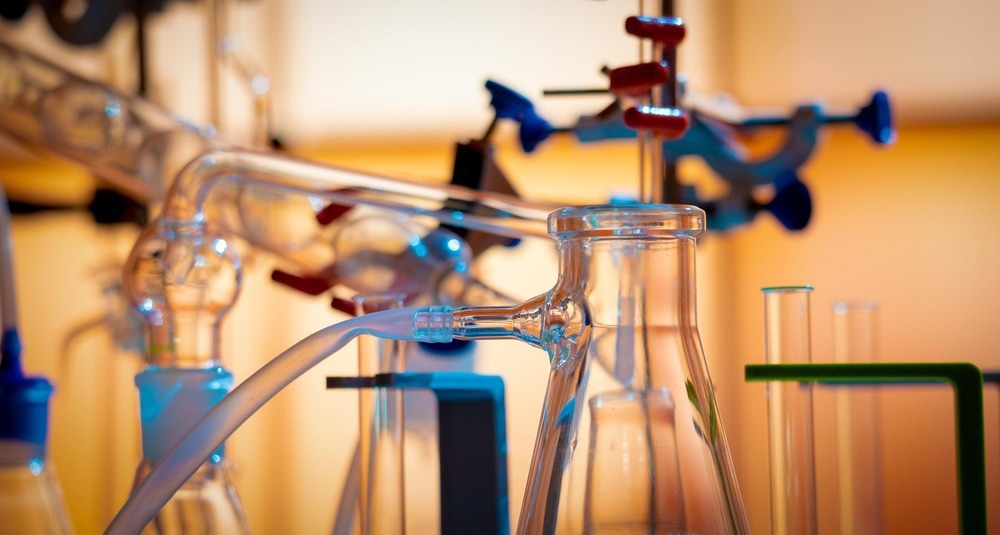Graphitic carbon nitride/graphene hybrids for electrocatalysis of oxygen reduction reactions (ORR) in metal-air fuel cells and batteries are proven to be viable, inexpensive, and long-lasting alternatives for platinum-based electrocatalytic materials.

Study: Graphitic carbon nitride on reduced graphene oxide prepared via semi-closed pyrolysis as electrocatalyst for oxygen reduction reaction. Image Credit: pinkeyes/Shutterstock.com
In a study published in the journal Materials Chemistry and Physics, a simple approach for producing graphitic carbon nitride on reduced graphene oxide was shown using semi-closed pyrolysis of graphene oxide and urea in ambient conditions contributing to viable carbon-based ORR electrocatalysts.
An Introduction to Oxygen Reduction Reactions
The oxygen reduction reaction is critical in energy studies since it accounts for about 50% of the total electrolytic processes in air-breathing fuel cells and batteries.
Owing to the many adsorptive or desorption steps that happen throughout the process, which generally lead to the formation of diverse oxygen species (like O, O2-, H2O, OH-, H2O2), the ORR is renowned for being slow and permanent in an aqueous setting.
As it is well understood that the oxygen reduction reaction is the kinetically restricting element in most electrolytic energy systems, attempts are being made to optimize the reaction using electrocatalysis.
Carbon-based Nanotechnology – The Future of Fuel Cells?
Carbonaceous nanostructures have fueled interest following a growing desire for cost-effective resistance against corrosion, high contact areas, varied pore architectures, surface and bulk properties, and environmental compatibility.
Nitrogen-containing carbonaceous nanostructures had been demonstrated to be a viable, inexpensive, and poisoning-resistant alternative for ORR electrocatalysts based on platinum, with some having similar or better ORR action than the more costly alternatives like platinum-based electrocatalysts.
As a result of their graphitic and nitrogen-rich nanoscale architecture, graphitic carbon nitrides (g-C3N4) have the highest promise for ORR electrocatalysis. g-C3N4, often used for photocatalysis in organic contaminant decomposition, was previously underutilized as a possible ORR electrocatalyst because of its low conductance.
Using an additional carbonaceous supporting framework, like graphene, enhances the conductance and surface area of g-C3N4, resulting in improved usability for ORR electrocatalysis.
Semi-Closed Pyrolysis Vs. Existing Synthesis Techniques
A review of the existing research found that most approaches for producing g-C3N4@graphene composites depend on tubular furnaces filled with nitrogen or argon gas, which offers an oxygen-free environment for the pyrolytic process but restricts the process's scaling potential.
Furthermore, most synthesis methods begin with g-C3N4 precursors which are potentially harmful to people or the planet or extremely volatile and challenging to manufacture on a bigger scale.
Functionally speaking, semi-closed pyrolysis may be defined as the high heat, thermochemical transformation of materials in ambient pressure and atmospheric settings. Semi-closed pyrolysis typically involves a porcelain furnace and a muffle oven, in contrast with pyrolytic processes that need a tubular furnace to enable the movement of inert chemicals.
Even though the semi-closed pyrolytic ambient air settings may encourage the burning of carbon to carbon-monoxide or -dioxide, resulting in a drop in electrocatalytic output, it has the benefit of fewer complications and being more economical than those generated on a lab-scale via a tubular furnace.
Important Conclusions
This paper describes a simple technique for synthesizing g-C3N4@rGO oxygen reduction reaction electrocatalyst by semi-closed pyrolysis of graphene oxide and urea. The results of XRD and FTIR analyses indicated that the desired g-C3N4/rGO interlayer composite was successfully formed.
The resultant g-C3N4@rGO had around 12 percent nitrogen, with 61 percent consisting of the desired graphitic and pyridinic N. Given the availability of active areas in g-C3N4 and N-loaded reduced graphene oxide, electrochemical analysis showed that the g-C3N4@rGO produced by semi-closed pyrolysis might catalyze ORR in alkaline conditions.
The electrochemical analysis revealed similar but poorer ORR performance compared to Pt/C. Regarding electrolytic stability, g-C3N4@rGO was shown to be better than Pt/C.
Despite its comparatively inferior performance in ORR electrocatalysis in contrast with other g-C3N4/graphene hybrids, the semi-closed pyrolysis approach was simpler and cheaper than alternative techniques in the literature.
The employment of urea as a g-C3N4 precursor increased this method's benefits by offering a low-cost, sustainable, and safe raw ingredient for producing ORR electrocatalysts. To enhance the advantages of g-C3N4@rGO in ORR electrocatalysis, additional improvement of the semi-closed pyrolysis technique would be required.
Reference
Garcia, J. L., Miyao, T., Inukai, J., & Tongol, B. J. (2022). Graphitic carbon nitride on reduced graphene oxide prepared via semi-closed pyrolysis as electrocatalyst for oxygen reduction reaction. Materials Chemistry and Physics. Available at: https://doi.org/10.1016/j.matchemphys.2022.126415
Disclaimer: The views expressed here are those of the author expressed in their private capacity and do not necessarily represent the views of AZoM.com Limited T/A AZoNetwork the owner and operator of this website. This disclaimer forms part of the Terms and conditions of use of this website.